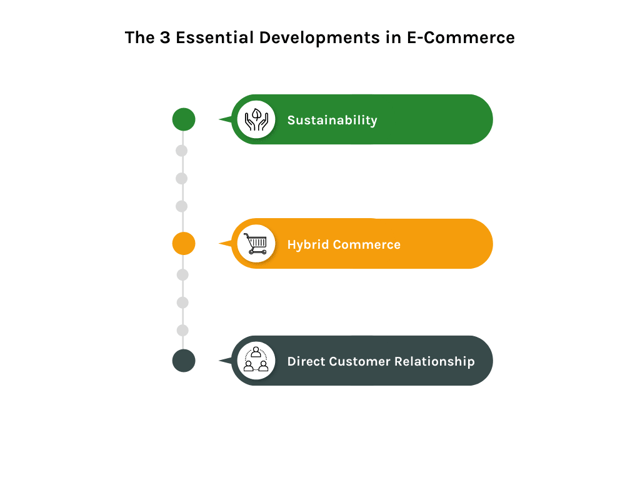The Top 3 Developments in 2022 in the E-Commerce Sector
Reading Time 5 mins | January 24, 2022 | Written by: AX Semantics

Digital Business Expert Oliver Kling talks about the Trends in Online Commerce
Oliver Kling holds a master's degree in Sociology and specializes in economics, business and digital transformation. Having a background in e-business since 2013, he consults mid-sized and multinational companies on how to build digital marketing, sales and service solutions.
The 3 Essential Developments in E-Commerce
E-commerce, the digitalization of marketing, sales and service in retail and industry, are now extremely multifaceted.
Oliver Kling has closely looked at the trends in online commerce. In his view, the top 3 developments in e-commerce are straightforward:
1. Sustainability
2. Hybrid Commerce – i.e., the integration of online and offline commerce
3. A direct customer relationship in terms of "Own the Customer Relation!".

1. Sustainability: 3 Specific Action Approaches
When it comes to sustainability, the following three action approaches are highly significant for e-commerce companies:
Reduce Return Rates
Accurate and extensive product information is particularly important. The topic of "sizing" deserves special mention. No two brands of shoes, tops or pants have identical measurements of the same size. Retailers that can provide information about lengths and widths can evaluate comparable sizes at the very best. In this way, the risk of returns is minimized and the customer satisfaction is simultaneously improved. A large number of product texts can also be generated quite conveniently using automated product descriptions.
Reduce Energy Consumption
There are effective sustainability levers when it comes to user experience (UX). Any click not made and any byte not loaded saves computing power and therefore energy. Image and video optimization as well as sustainable UX are the keywords in this context. Ultimately, Green-IT has huge potential for sustainability.
This is especially the case when used in connection with cloud solutions, where energy consumption can be reduced by up to 45%.
CO2 Reduction
When it comes to sustainability, manufacturers have exclusive control. Being the ones responsible for the value chain in the manufacturing process of their products, they have the chance - and also the duty - to make their production more sustainable and resource-saving. This is achieved through CO2 reduction, less toxins and modern hydro systems, for example.
2. Hybrid Commerce - The Integration of Online and Offline Commerce
The integration process starts inside the head! By continuing to assign channel qualities to both online and offline, while no longer distinguishing between e-commerce and stationary retail.
Customers are expecting a more consistent brand experience across channels. As "channel-hoppers," customers no longer distinguish between online and offline.
Retailers should follow this example when thinking about their sales, marketing, and service activities in digital and hybrid terms! More specifically, it requires shared systems and processes. CRM, marketing automation, POS system and merchandise management must be centralized digitally.
Two Examples of Channel Integration
Example 1: From Online to Offline
When the web store notices that the products in the shopping cart are available in different sizes in a store nearby using geo-tracking or zip code input, for example, an in-store appointment offering fitting and advice sounds appealing.
Example 2: From Offline to Online
Likewise, in-store customers don't want to carry heavy bags around and are glad to have their in-store purchases delivered home the following day.
The business question is: Which channel can offer the greatest possible added value at which point in time for the customer and how can the channel change process be made to run smoothly? With a clear customer journey, ideas and technical solution scenarios emerge automatically.
3. "Own the Customer Relation": How Brands are Strengthening the Relationship with their Customers in the Age of the Platform
Direct-to-consumer (D2C) solutions like “showrooming” are becoming increasingly successful among brands. This is good news for manufacturers, yet bad news for replaceable retailers.
Retailers now have to redefine their added value for customers. This requires market niches, consulting, brand selection and expertise. This is often something that brands themselves cannot provide. Yet retailers and brands must equally place their focus on content and experience to win the relationship with the customer - and thus their trust. Community building is the keyword in this context - i. e., turning customers into fans.
About the Author

Oliver Kling is a digital business analyst & author at handelskraft.de, host of the B2B Digital Masters Convention, the Handelskraft Conference & the Digital Business Talk Podcast, as well as Head of Marketing at the digital agency dotSource.
His responsibilities there include the brands dotSource, Handelskraft and Digital Business School. His work involves creating and distributing relevant and emotional content for decision-makers from marketing, sales and IT in collaboration with his team. Their goal in this respect is clear: delivering trends, analyses and clear text on requirements and opportunities from a technical, process and, ultimately, user perspective in e-business. In doing so, they help the companies to become digital champions in their target group.
